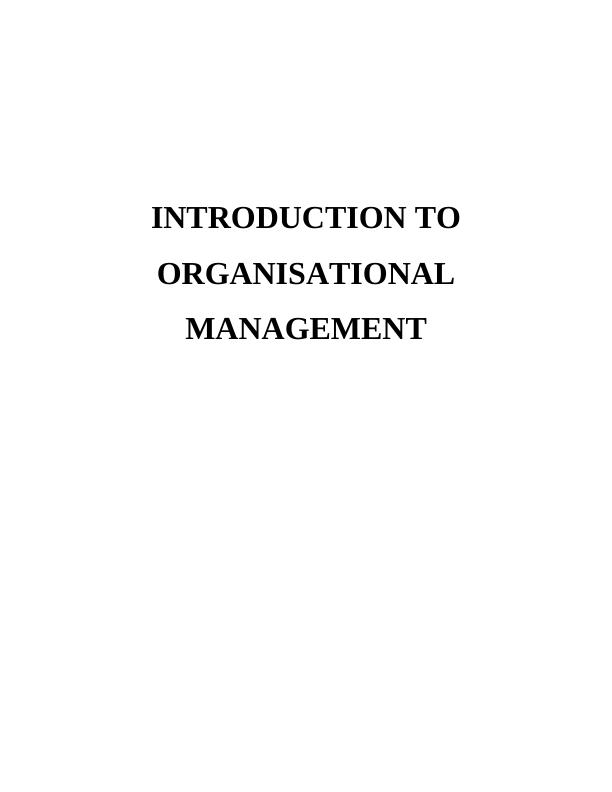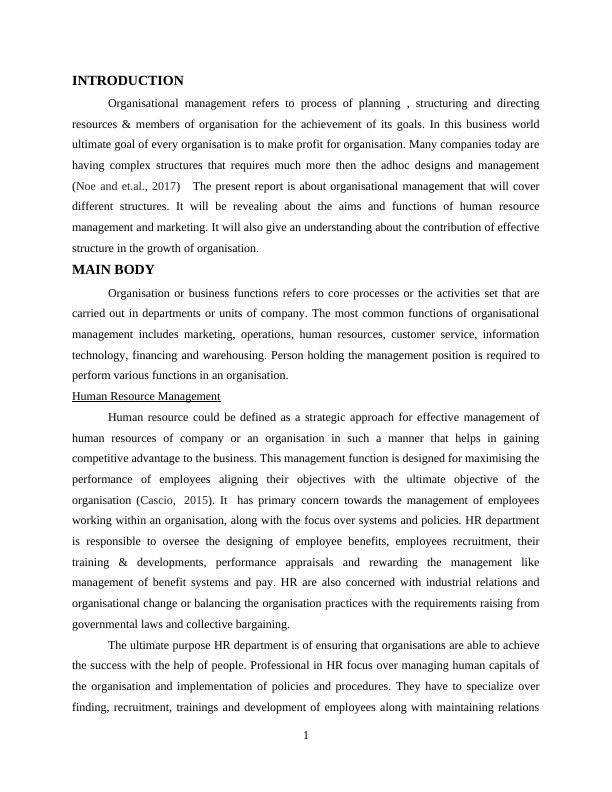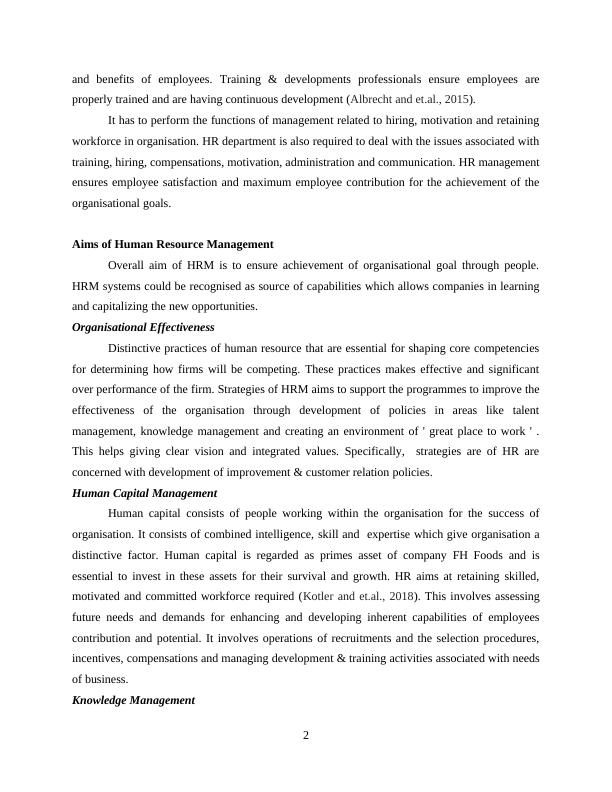Introduction to Organisational Management
Added on 2023-01-18
12 Pages2985 Words92 Views
INTRODUCTION TO
ORGANISATIONAL
MANAGEMENT
ORGANISATIONAL
MANAGEMENT

TABLE OF CONTENTS
INTRODUCTION...........................................................................................................................1
MAIN BODY...................................................................................................................................1
CONCLUSION................................................................................................................................1
REFERENCES................................................................................................................................2
INTRODUCTION...........................................................................................................................1
MAIN BODY...................................................................................................................................1
CONCLUSION................................................................................................................................1
REFERENCES................................................................................................................................2

INTRODUCTION
Organisational management refers to process of planning , structuring and directing
resources & members of organisation for the achievement of its goals. In this business world
ultimate goal of every organisation is to make profit for organisation. Many companies today are
having complex structures that requires much more then the adhoc designs and management
(Noe and et.al., 2017) The present report is about organisational management that will cover
different structures. It will be revealing about the aims and functions of human resource
management and marketing. It will also give an understanding about the contribution of effective
structure in the growth of organisation.
MAIN BODY
Organisation or business functions refers to core processes or the activities set that are
carried out in departments or units of company. The most common functions of organisational
management includes marketing, operations, human resources, customer service, information
technology, financing and warehousing. Person holding the management position is required to
perform various functions in an organisation.
Human Resource Management
Human resource could be defined as a strategic approach for effective management of
human resources of company or an organisation in such a manner that helps in gaining
competitive advantage to the business. This management function is designed for maximising the
performance of employees aligning their objectives with the ultimate objective of the
organisation (Cascio, 2015). It has primary concern towards the management of employees
working within an organisation, along with the focus over systems and policies. HR department
is responsible to oversee the designing of employee benefits, employees recruitment, their
training & developments, performance appraisals and rewarding the management like
management of benefit systems and pay. HR are also concerned with industrial relations and
organisational change or balancing the organisation practices with the requirements raising from
governmental laws and collective bargaining.
The ultimate purpose HR department is of ensuring that organisations are able to achieve
the success with the help of people. Professional in HR focus over managing human capitals of
the organisation and implementation of policies and procedures. They have to specialize over
finding, recruitment, trainings and development of employees along with maintaining relations
1
Organisational management refers to process of planning , structuring and directing
resources & members of organisation for the achievement of its goals. In this business world
ultimate goal of every organisation is to make profit for organisation. Many companies today are
having complex structures that requires much more then the adhoc designs and management
(Noe and et.al., 2017) The present report is about organisational management that will cover
different structures. It will be revealing about the aims and functions of human resource
management and marketing. It will also give an understanding about the contribution of effective
structure in the growth of organisation.
MAIN BODY
Organisation or business functions refers to core processes or the activities set that are
carried out in departments or units of company. The most common functions of organisational
management includes marketing, operations, human resources, customer service, information
technology, financing and warehousing. Person holding the management position is required to
perform various functions in an organisation.
Human Resource Management
Human resource could be defined as a strategic approach for effective management of
human resources of company or an organisation in such a manner that helps in gaining
competitive advantage to the business. This management function is designed for maximising the
performance of employees aligning their objectives with the ultimate objective of the
organisation (Cascio, 2015). It has primary concern towards the management of employees
working within an organisation, along with the focus over systems and policies. HR department
is responsible to oversee the designing of employee benefits, employees recruitment, their
training & developments, performance appraisals and rewarding the management like
management of benefit systems and pay. HR are also concerned with industrial relations and
organisational change or balancing the organisation practices with the requirements raising from
governmental laws and collective bargaining.
The ultimate purpose HR department is of ensuring that organisations are able to achieve
the success with the help of people. Professional in HR focus over managing human capitals of
the organisation and implementation of policies and procedures. They have to specialize over
finding, recruitment, trainings and development of employees along with maintaining relations
1

and benefits of employees. Training & developments professionals ensure employees are
properly trained and are having continuous development (Albrecht and et.al., 2015).
It has to perform the functions of management related to hiring, motivation and retaining
workforce in organisation. HR department is also required to deal with the issues associated with
training, hiring, compensations, motivation, administration and communication. HR management
ensures employee satisfaction and maximum employee contribution for the achievement of the
organisational goals.
Aims of Human Resource Management
Overall aim of HRM is to ensure achievement of organisational goal through people.
HRM systems could be recognised as source of capabilities which allows companies in learning
and capitalizing the new opportunities.
Organisational Effectiveness
Distinctive practices of human resource that are essential for shaping core competencies
for determining how firms will be competing. These practices makes effective and significant
over performance of the firm. Strategies of HRM aims to support the programmes to improve the
effectiveness of the organisation through development of policies in areas like talent
management, knowledge management and creating an environment of ' great place to work ' .
This helps giving clear vision and integrated values. Specifically, strategies are of HR are
concerned with development of improvement & customer relation policies.
Human Capital Management
Human capital consists of people working within the organisation for the success of
organisation. It consists of combined intelligence, skill and expertise which give organisation a
distinctive factor. Human capital is regarded as primes asset of company FH Foods and is
essential to invest in these assets for their survival and growth. HR aims at retaining skilled,
motivated and committed workforce required (Kotler and et.al., 2018). This involves assessing
future needs and demands for enhancing and developing inherent capabilities of employees
contribution and potential. It involves operations of recruitments and the selection procedures,
incentives, compensations and managing development & training activities associated with needs
of business.
Knowledge Management
2
properly trained and are having continuous development (Albrecht and et.al., 2015).
It has to perform the functions of management related to hiring, motivation and retaining
workforce in organisation. HR department is also required to deal with the issues associated with
training, hiring, compensations, motivation, administration and communication. HR management
ensures employee satisfaction and maximum employee contribution for the achievement of the
organisational goals.
Aims of Human Resource Management
Overall aim of HRM is to ensure achievement of organisational goal through people.
HRM systems could be recognised as source of capabilities which allows companies in learning
and capitalizing the new opportunities.
Organisational Effectiveness
Distinctive practices of human resource that are essential for shaping core competencies
for determining how firms will be competing. These practices makes effective and significant
over performance of the firm. Strategies of HRM aims to support the programmes to improve the
effectiveness of the organisation through development of policies in areas like talent
management, knowledge management and creating an environment of ' great place to work ' .
This helps giving clear vision and integrated values. Specifically, strategies are of HR are
concerned with development of improvement & customer relation policies.
Human Capital Management
Human capital consists of people working within the organisation for the success of
organisation. It consists of combined intelligence, skill and expertise which give organisation a
distinctive factor. Human capital is regarded as primes asset of company FH Foods and is
essential to invest in these assets for their survival and growth. HR aims at retaining skilled,
motivated and committed workforce required (Kotler and et.al., 2018). This involves assessing
future needs and demands for enhancing and developing inherent capabilities of employees
contribution and potential. It involves operations of recruitments and the selection procedures,
incentives, compensations and managing development & training activities associated with needs
of business.
Knowledge Management
2

End of preview
Want to access all the pages? Upload your documents or become a member.
Related Documents
Human Resource Management Assignment - Solutionlg...
|16
|4208
|391
Importance of HRM Practices for Employer and Employeelg...
|17
|4889
|231
Unit 3 - Human Resource Managementlg...
|19
|4035
|73
HUMAN RESOURCE MANAGEMENT INTRODUCTION 1 PURPOSES AND FUNCTIONSlg...
|16
|3975
|440
Human Resource Management Strengths and Weaknesseslg...
|16
|3873
|309
Importance of HRM Functions in Workforce Planninglg...
|16
|3785
|29
